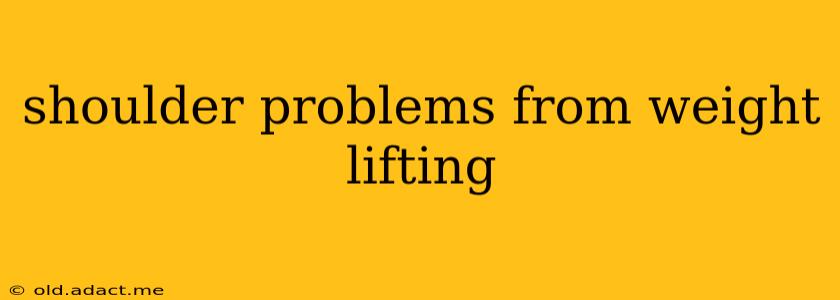Weightlifting, while incredibly beneficial for building strength and improving overall fitness, carries the risk of injury, particularly to the shoulders. The complex nature of the shoulder joint, with its intricate network of muscles, tendons, and ligaments, makes it vulnerable to various problems. Understanding these potential issues and implementing preventative measures is crucial for maintaining shoulder health and continuing your weightlifting journey.
What are the Common Shoulder Problems from Weight Lifting?
Several shoulder problems can arise from improper weightlifting techniques, excessive training, or pre-existing conditions. Some of the most common include:
-
Rotator Cuff Injuries: The rotator cuff is a group of four muscles and their tendons that stabilize the shoulder joint. Overuse, improper form, or sudden impact can lead to strains, tears, or tendinitis. Symptoms often include pain, weakness, and limited range of motion.
-
Shoulder Impingement Syndrome: This condition occurs when the tendons and bursa (fluid-filled sac) around the shoulder joint become compressed, causing inflammation and pain. Repetitive overhead movements are a common culprit.
-
Labral Tears: The labrum is a ring of cartilage that surrounds the shoulder socket. Tears can occur due to trauma or repetitive stress, leading to pain, clicking, and instability.
-
AC Joint Injuries: The acromioclavicular (AC) joint connects the collarbone (clavicle) to the shoulder blade (scapula). Direct impact or repetitive overhead lifting can cause sprains or separations.
-
Biceps Tendinitis: Inflammation of the biceps tendon can occur due to overuse or improper lifting techniques. Pain in the front of the shoulder is a characteristic symptom.
-
Bursitis: Inflammation of the bursae, fluid-filled sacs that cushion the shoulder joint, can cause pain and limited movement.
How Can I Prevent Shoulder Problems from Weightlifting?
Preventing shoulder injuries is paramount. Here's how:
-
Proper Warm-up: Always begin with a thorough warm-up that includes dynamic stretches focusing on the shoulder girdle. This prepares the muscles and increases blood flow.
-
Correct Form: Master the correct form for each exercise. Using improper form significantly increases your risk of injury. Consider working with a qualified trainer to ensure you're lifting correctly.
-
Progressive Overload: Gradually increase the weight, reps, and sets over time. Avoid sudden jumps in intensity, which can overwhelm your muscles and joints.
-
Adequate Rest and Recovery: Allow sufficient time for rest and recovery between workouts. Overtraining is a major contributor to shoulder injuries. Get enough sleep and incorporate rest days into your training schedule.
-
Strength Balance: Focus on strengthening not just the muscles involved in lifting, but also the stabilizing muscles of the shoulder girdle. This creates a more balanced and resilient shoulder joint.
-
Listen to Your Body: Pay attention to your body's signals. If you experience pain, stop immediately and rest. Ignoring pain can lead to more severe injuries.
What are the Symptoms of Shoulder Problems from Weightlifting?
Symptoms vary depending on the specific injury, but common signs include:
-
Pain: Pain is a primary indicator, ranging from mild discomfort to severe, sharp pain.
-
Weakness: Difficulty lifting or performing certain movements.
-
Stiffness: Reduced range of motion in the shoulder.
-
Clicking or Popping: Sounds originating from the shoulder joint.
-
Swelling: Inflammation around the shoulder.
-
Limited Mobility: Inability to fully raise or rotate your arm.
How are Shoulder Problems from Weightlifting Treated?
Treatment depends on the severity of the injury and may include:
-
Rest and Ice: Initial treatment often involves rest, ice application, and over-the-counter pain relievers.
-
Physical Therapy: A physical therapist can guide you through exercises to improve strength, mobility, and range of motion.
-
Medication: In some cases, your doctor may prescribe anti-inflammatory medications or pain relievers.
-
Corticosteroid Injections: These injections can help reduce inflammation and pain.
-
Surgery: In severe cases, surgery may be necessary to repair a torn rotator cuff or other significant damage.
Can I still lift weights if I have shoulder pain?
If you experience shoulder pain, it's crucial to consult a healthcare professional. They can accurately diagnose the issue and recommend the appropriate course of action. Attempting to continue weightlifting with existing shoulder pain can exacerbate the injury. Modified exercises or a temporary break from weightlifting may be necessary.
How long does it take to recover from a shoulder injury from weightlifting?
Recovery time varies considerably depending on the severity of the injury and the individual's response to treatment. Minor injuries may heal within a few weeks, while more serious injuries could require several months or even longer to fully recover.
This information is for general knowledge and does not constitute medical advice. Always consult with a qualified healthcare professional before starting any exercise program or seeking treatment for an injury. Remember, prioritizing proper form, progressive overload, and adequate rest are key to preventing shoulder problems and enjoying the benefits of weightlifting safely.
